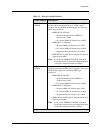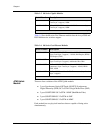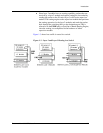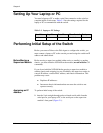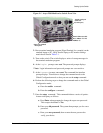
1-20 User Guide for the Avaya P580 and P882 Multiservice Switches, v6.1
Chapter 1
50-Series Buffers and Queues
Buffer and queue management relieves congestion in a network. Adding
gigabit speeds to existing networks means that there can be a huge disparity
between link speeds. For example, anything more than a 1-percent load on a
gigabit link could easily overwhelm a 10 Mb/s Ethernet link.
Each switch employs the following buffer and queue management
techniques:
■ Configurable active backpressure:
— Half-duplex ports use active backpressure to jam input ports
when their frame buffers are full.
— Full-duplex links use IEEE 802.3z pause control frames to
pause traffic when buffers are full.
■ Packed frame buffers for optimal memory utilization. The memory
management allows virtually 100% utilization of buffer memory.
■ Two CoS priority queues for 50-Series modules and eight CoS
priority queues for 80-Series modules provide flexible queue
management algorithms to meet application requirements.
■ Configurable queue depth for each prioritized packet queues.
■ Configurable priority threshold.
■ Configurable service ratio tunes queue priority.
For more information on 50-series buffers and queues, see Chapter 24,
“Managing Buffers and Queues on 50-Series Modules.”
80-Series QoS
Quality of Service (QoS) is a set of tools that make it possible for you to
manage traffic across a switch or a network. These tools protect specific
traffic from the effects of network congestion. You can enable these features
for a module or individual ports on a module to control the flow of traffic
across your network. This control makes it possible for you to guarantee
that delay-sensitive traffic such as voice over IP (VoIP) receives the priority
it requires, while also ensuring that the switch services other low priority
data.
QoS makes it possible for you to prioritize time-sensitive traffic and assign
larger amounts of bandwidth to those applications that require it.
For more information on QoS, see Chapter 25, “80-Series QoS.”




